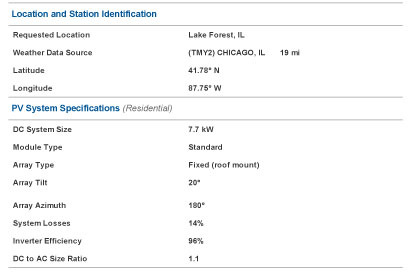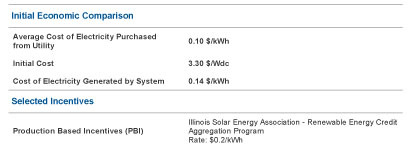Renewable energy production is a key part of creating sustainable landscapes. Even at the site scale, harnessing geothermal, wind, and solar energy are powerful strategies for reducing society’s dependency on fossil fuels. When dealing with photovoltaic installations on the residential level, a designer needs tools that allow him or her to make quick, conceptual decisions and provide the client with tangible, data-driven expectations.
That’s where PVWatts Calculator comes in. Managed by the National Renewable Energy Laboratory (NREL), the web-based tool provides baseline estimates for output levels and costs (both installation and production) of photovoltaic (PV) systems. It utilizes precise geographic location and correlating weather data to estimate the amount of solar energy available as a resource at any specific site. Then, based on a series of inputs to define the system – such as module type, array type, size, and tilt – the calculator estimates solar energy production. If a specific output is required, the program makes it easy to go back and fine tune the system details.
A sample set of inputs as defined for the PVWatts Calculator. All inputs have a default value which can be left if the value of the input is uncertain or modified to reflect a proposed installation.
A sample chart created by PVWatts Calculator of the annual estimated production of the defined system.
The calculator also produces estimates of energy production per month and collates the annual value of the produced energy based on a user-provided utility rate. As a result, the user can then compare the cost per kilowatt hour of the electricity produced by the system with energy from a utility company, factoring in applicable incentives. This comparison allows a designer to assess the system’s economic viability easily and estimate how long a client will take to recoup the investment spent on a solar energy system.
Sample economic data produced by the PVWatts Calculator.
Certainly, the site has its limitations. It does not allow detailed specification of hardware and makes a number of baseline assumptions which may or may not be true. It is also geared toward small installations—though NREL does provide links to other resources which are designed for both greater detail and scale. Regardless, it is a great tool for what it was designed: delivering quick and clear data regarding residential solar production, helping designers make intelligent choices at the conceptual stage.
Follow the link to try the PVWatts Calculator out! It’s easy to use.
Here are some other helpful links NREL hosts on its website:
Lead image credit: Bernd Slekr, Pink Dispatcher (c) 2007, adapted with title banner by Nicholas Buesking, used under the Attribution-ShareAlike 2.0 License
Published in Blog








![Assuming Beauty [Video]](https://land8.com/wp-content/uploads/2019/05/walker-macy-lara-rose-land8x8-224x150.png)




